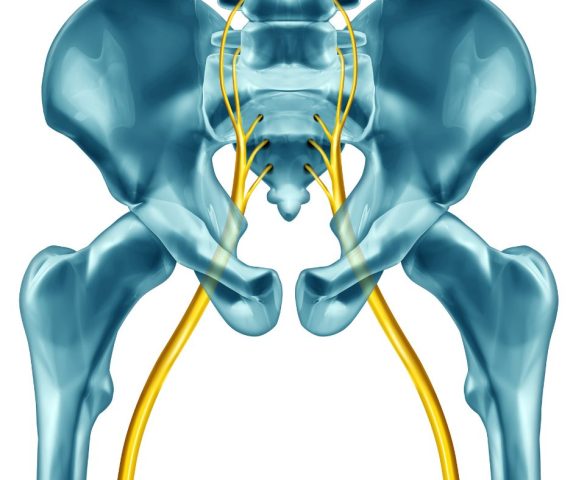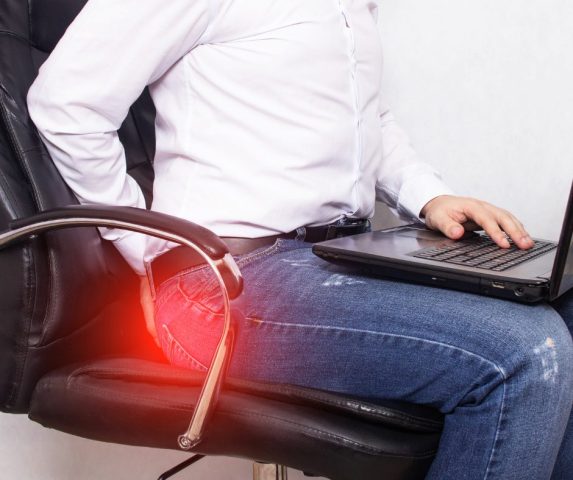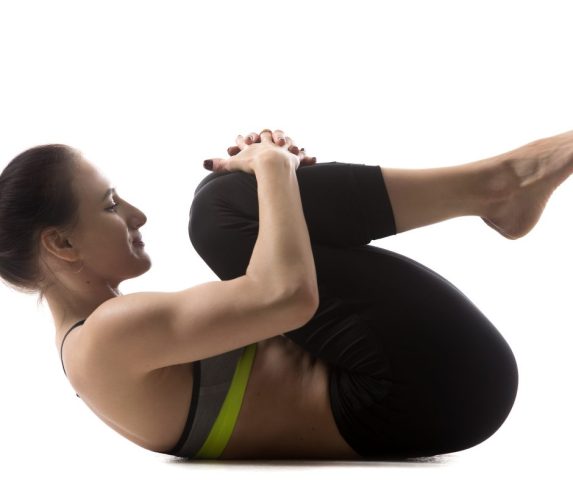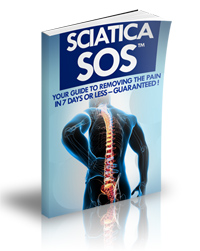Simple Sciatica Stretches for Sciatica Pain Relief: Complete Guide 2024
By Vanessa Richards
January 10, 2024 • Fact checked by Dumb Little Man

Sciatica is a popular medical term defined as intense pain. It tends to radiate along the sciatic nerve, which goes from the lower back and extends down each leg.
Normally, sciatica will affect one part of your body. However, there are more severe situations when it targets both legs, yet such cases are rare.
There are more causes behind sciatica, but most commonly, it occurs when a herniated disk compresses parts of the sciatica nerve. It may also be caused by spinal narrowing and other similar issues.
As a direct consequence, this type of inflammation will most commonly lead to pain. Luckily, there are ways to overcome this problem.
Sciatic Stretches: What is the Sciatic Nerve?

The sciatic nerve is the largest and longest nerve in the human body. Given its size and location, it is extremely important. It starts outside the spine, around the lower back. It travels throughout the lower body, so it goes over the pelvis and butt, as well as the thighs. There are parts of it in each leg.
The nerve is mixed, meaning it has multiple types of fibers. Most importantly, it has sensory fibers for sensations and motor fibers for movement. All in all, the role of this nerve goes in more directions. It is responsible for your ability to stand, walk or run.
The sciatic nerve is exposed to various factors given its size and distribution throughout the body. It goes around the spine too. Any defective mechanism or issue around the nerve can put pressure on it, hence the inflammation. Despite its size, it is quite sensitive.
Five different nerve roots make up the sciatic nerve. Two of these roots start in the lower back, by the lumbar spine. Three other roots start by the bottom side of the spine – the sacrum. Altogether, they make up the nerve.
All these roots join together by the base of the spine. Left roots will form the left sciatic nerve, while the right roots will bring in the right sciatic nerve.
Now that you know a few things about the nerve, how do you deal with the sciatic nerve pain? What should you know about the sciatica pain?
What Causes Sciatic Pain?

There are more things that can affect the piriformis muscle and cause sciatica. Luckily, some of them are reversible. There are stretches for sciatica, as well as physical therapy you can take with a specialist doctor.
Age is the most common cause of sciatica. It is not an actual cause though. As you grow older, your body will also change – not to mention the spine. Therefore, small issues are more likely to occur, including sciatica symptoms.
The sciatic nerve irritation can be caused by bone spurs, as well as herniated disks. Sure, they can affect younger adults too, but elders are more likely to face such problems. On the same note, older patients will find it more difficult to treat sciatica.
Obesity is another cause. Extra weight is practically extra stress on the spine. The sciatic nerve glide will be affected. Sooner or later, pain will inevitably kick in, and this is when you need to find sciatica pain relief solutions. The good news is there are plenty of sciatica exercises out there.
Your job and lifestyle are not to be overlooked either. A job that implies twisting your back, carrying heavy items, or even driving for long periods of time may underline the necessity of a standing piriformis stretch – as well as other sciatica stretches.
Prolonged sitting is, therefore, an issue. A sedentary lifestyle can put pressure on the sciatic nerve. But even if you do have a job and you actually work hard, sitting for too long may lead to sciatica – in this case, a long adductor muscle stretch is usually enough.
Finally, the leg pain – as well as the lumbar spinal stenosis – can be triggered by diabetes too. It works the way your body uses blood sugar. Therefore, the risks of nerve damage are significantly higher.
Tips to Ease Sciatic Pain
Simple Sciatica Stretches
Most doctors recommend a hamstring stretch or a gentle pull for pain relief. Here are a few stretches.
Reclining Pigeon Pose

The starting position is similar to a yoga one. Relax on your back and bring the left foot up – you need a right angle. Keep both hands by the knee of the bent leg.
The other leg should be lifted – place the ankle on the knee of your left leg. Hold this position, then switch legs.
Knee to Shoulder Pose

You need to lie flat on your back and keep both legs extended. Bend the left leg, but also clasp hands by the left knee. Slowly pull this leg towards the opposite shoulder. It may feel natural to lean forward or bend forward a little.
Ignore the opposite knee. Wait for a few seconds, then swap legs.
Keep the knees bent based on which side you do.
Sitting spinal stretch

You need to sit down on the ground for this stretch to relieve pain. Keep legs extended right in front of you. Bend the right leg by the knee and place the right foot flat on the floor – on the outside of the left leg. The right ankle should be slightly oblique by the ground. The opposite leg is unmoved.
The left elbow must be placed outside the right knee. The left thigh is the only one moving. Hold this pose for half a minute and switch sides. This move will work on the tiny piriformis muscle and will provide a deeper stretch of the lumbar spine, not to mention affecting abdominal muscles.
It will also prevent piriformis syndrome.
A few other stretches worth some attention include:
- Seated spinal twist
- Any standing stretch
- Sitting pigeon pose
- Forward pigeon pose
- Standing hamstring stretch
- Basic seated stretch
- Standing piriformis stretch
>> Related Article: How to Get Rid of Knee Pain Fast: Complete Guide 2024
Natural Remedies
Your physical therapist will recommend the natural approach before suggesting any medications.
Exercise
Exercising may feel unnatural when you suffer from sciatica. Practically, you do not want to keep the knee bent or stretch lying on your back. You just want to keep the spine straight and avoid anything that could put pressure on hamstring muscles.
However, resting for too long can aggravate the affected leg. Mild exercises will relieve pressure and pain. Your workouts should not be intense or tiring. Instead, you can take a nice walk around the area. Once you find an exercise that works for you, perform the same exercise again and again.
Use heating pads and ice packs
Both therapies could work. In fact, the spinal cord will benefit from alternating therapies. Take a deep breath and enjoy. Ice will help you ameliorate inflammation. Heat, on the other hand, brings more blood to the area, meaning the healing process is faster.
When you go for the cold therapy, apply an ice pack on the affected area for about 15 minutes – repeat every 90 minutes. Heat can be applied for 15 minutes every three hours. Always use a towel or you risk damaging the skin.
Change your posture
Your posture can worsen your sciatica, but it can also improve and ameliorate painful sensations. It makes no difference if you work in an office or you spend your time relaxing at home. Being in the same position for hours will make your sciatic pains spike.
Change your posture every 20 minutes, and make sure you adopt a healthy posture. If you have to stand or need to keep one leg on top of the other, switch legs as well. A healthy posture will work wonders in the long run.
Medications
It is important to contact your doctor if the pain becomes severe or you experience numbness or weakness. If the pain does not improve the natural way in a couple of weeks, seek help from a doctor – the same rule applies to loss of bladder or bowel control.
Oral medications include over-the-counter painkillers – aspirin, acetaminophen, and even NSAIDs, including ibuprofen. Doctors may also prescribe muscle relaxants if you experience muscular spasms – more severe cases. You cannot normally get them over the counter.
If the back pain turns chronic and fails to go away, some doctors may prescribe antidepressants. Even if you do not suffer from depression, some antidepressants can help against these pains. Finally, there are more powerful painkillers to handle severe pain – you will most likely need a prescription.
In severe cases, steroids could be injected around the spinal nerve to ameliorate the problem. The effect depends on what causes the sciatic pain in the first place. Furthermore, such injections can only be given by doctors.
Supplements
There are lots of supplements out there based on natural products – this is what you need to look for. Also, look for ingredients with proven effects as painkillers.
Here are some of the most popular ones for sciatica:
- Fish oil
- Glucosamine
- Boswellia
- Devil’s claw
- Chondroitin
While not necessarily supplements, natural programs or books are also worth some attention.
Digital Program
The Best Program To Reduce Sciatic Pain Intensity: Sciatica SOS Program by Glen Johnson
A comprehensive program aimed at annihilating sciatic pain within a week or two, with an impressive success rate.
Based on free advice you can find online, the skepticism regarding premium programs, and the intensity of sciatic pains, Sciatica SOS is by far the most cost-effective option on the market.
The program brings in no risks whatsoever but a mix of different techniques to tackle the condition
Shop Sciatica SOS at Official Website.
Full Article: Sciatica SOS Glen Johnson Reviews 2024: Does it Really Work?
The Takeaway
You might be able to get rid of sciatica without doing anything at all. Obviously, it will take months to overcome it this way. There are numerous natural ideas to get rid of this pain too, and this is the most popular approach.
You can set your own program yourself, or you can take the easy path – follow a program with proven results. While there are lots of options out there, Sciatica SOS has the best reputation for some good reasons. It is inexpensive and promotes sciatica stretches, rather than medications and drugs.
It is a fully 100% natural approach that boosts a convenient way to treat sciatica.
Click Here to Get Sciatica SOS Program at a Discounted Price.
Sciatica Stretches FAQs
What activities should be avoided with sciatica?
In theory, resting all the time makes sense, but it is contraindicated. You need to exercise and stretch – mild exercises though, and not too tiring. However, there are also some activities that can make sciatic pains even worse.
Lifting both legs off the ground is highly contraindicated. On the same note, squatting is a forbidden exercise – as well as any type of high impact training. Avoid rotating or twisting the upper body, too, not to mention bending while keeping your legs straight.
Do you ever fully recover from sciatica?
Sciatic pains can become quite severe and problematic, but the good news is most people will be able to treat it. You will usually overcome it with nothing but regular rest, a few simple lifestyle changes, and self-care treatments.
Nine out of ten people can get better without requiring surgery. About 50% of them will recover within six weeks. In some cases, it may take less. Most commonly, it will take a bit more than six weeks, but you will definitely notice improvements much faster.
What is the best sitting position for sciatica?
Make sure you sit up straight. The back and buttocks should be well supported. Avoid sitting towards the front of the chair. Also, feet must be flat on the ground and not just the toes. Avoid leaning or crossing your legs.
Vanessa Richards
Vanessa is a mom of 3 lovely children and a software geek. Outside of her career as a health and wellness instructor. She enjoys writing and researching on topics such as finance, software, health and culinary.



